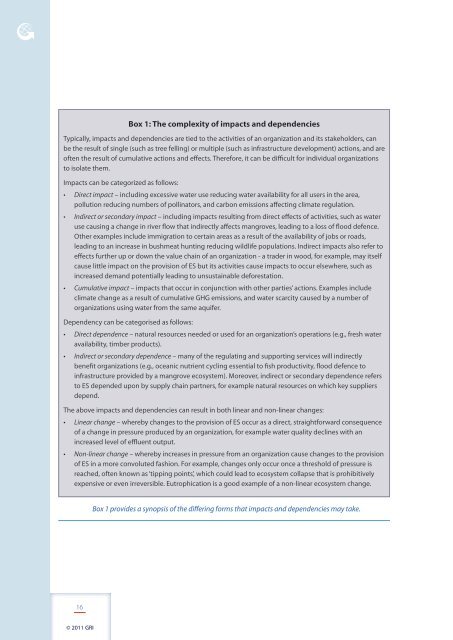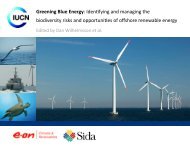Sustainability Reporting Today: The Readers’ VerdictBox 1: The complexity of impacts and dependenciesTypically, impacts and dependencies are tied to the activities of an organizati<strong>on</strong> and its stakeholders, canbe the result of single (such as tree felling) or multiple (such as infrastructure development) acti<strong>on</strong>s, and areoften the result of cumulative acti<strong>on</strong>s and effects. There<str<strong>on</strong>g>for</str<strong>on</strong>g>e, it can be difficult <str<strong>on</strong>g>for</str<strong>on</strong>g> individual organizati<strong>on</strong>sto isolate them.Impacts can be categorized as follows:• Direct impact – including excessive water use reducing water availability <str<strong>on</strong>g>for</str<strong>on</strong>g> all users in the area,polluti<strong>on</strong> reducing numbers of pollinators, and carb<strong>on</strong> emissi<strong>on</strong>s affecting climate regulati<strong>on</strong>.• Indirect or sec<strong>on</strong>dary impact – including impacts resulting from direct effects of activities, such as wateruse causing a change in river flow that indirectly affects mangroves, leading to a loss of flood defence.Other examples include immigrati<strong>on</strong> to certain areas as a result of the availability of jobs or roads,leading to an increase in bushmeat hunting reducing wildlife populati<strong>on</strong>s. Indirect impacts also refer toeffects further up or down the value chain of an organizati<strong>on</strong> - a trader in wood, <str<strong>on</strong>g>for</str<strong>on</strong>g> example, may itselfcause little impact <strong>on</strong> the provisi<strong>on</strong> of ES but its activities cause impacts to occur elsewhere, such asincreased demand potentially leading to unsustainable de<str<strong>on</strong>g>for</str<strong>on</strong>g>estati<strong>on</strong>.• Cumulative impact – impacts that occur in c<strong>on</strong>juncti<strong>on</strong> with other parties’ acti<strong>on</strong>s. Examples includeclimate change as a result of cumulative GHG emissi<strong>on</strong>s, and water scarcity caused by a number o<str<strong>on</strong>g>for</str<strong>on</strong>g>ganizati<strong>on</strong>s using water from the same aquifer.Dependency can be categorised as follows:• Direct dependence – natural resources needed or used <str<strong>on</strong>g>for</str<strong>on</strong>g> an organizati<strong>on</strong>’s operati<strong>on</strong>s (e.g., fresh wateravailability, timber products).• Indirect or sec<strong>on</strong>dary dependence – many of the regulating and supporting <strong>services</strong> will indirectlybenefit organizati<strong>on</strong>s (e.g., oceanic nutrient cycling essential to fish productivity, flood defence toinfrastructure provided by a mangrove <strong>ecosystem</strong>). Moreover, indirect or sec<strong>on</strong>dary dependence refersto ES depended up<strong>on</strong> by supply chain partners, <str<strong>on</strong>g>for</str<strong>on</strong>g> example natural resources <strong>on</strong> which key suppliersdepend.The above impacts and dependencies can result in both linear and n<strong>on</strong>-linear changes:• Linear change – whereby changes to the provisi<strong>on</strong> of ES occur as a direct, straight<str<strong>on</strong>g>for</str<strong>on</strong>g>ward c<strong>on</strong>sequenceof a change in pressure produced by an organizati<strong>on</strong>, <str<strong>on</strong>g>for</str<strong>on</strong>g> example water quality declines with anincreased level of effluent output.• N<strong>on</strong>-linear change – whereby increases in pressure from an organizati<strong>on</strong> cause changes to the provisi<strong>on</strong>of ES in a more c<strong>on</strong>voluted fashi<strong>on</strong>. For example, changes <strong>on</strong>ly occur <strong>on</strong>ce a threshold of pressure isreached, often known as ‘tipping points’, which could lead to <strong>ecosystem</strong> collapse that is prohibitivelyexpensive or even irreversible. Eutrophicati<strong>on</strong> is a good example of a n<strong>on</strong>-linear <strong>ecosystem</strong> change.Box 1 provides a synopsis of the differing <str<strong>on</strong>g>for</str<strong>on</strong>g>ms that impacts and dependencies may take.16© 2011 GRI
It should be realised <str<strong>on</strong>g>for</str<strong>on</strong>g> both dependencies andimpacts that:• These relati<strong>on</strong>ships are not mutuallyexclusive: more than <strong>on</strong>e of the aboverelati<strong>on</strong>ships can take place at the sametime. In fact, an organizati<strong>on</strong>’s dependence<strong>on</strong> a service may also lead to an impact,although this is not always the case. Also,many of the direct impacts will lead toindirect impacts to occur. Reduced wateravailability leading to a loss of habitat andassociated <strong>services</strong> is <strong>on</strong>e example.• All of these can occur over differentgeographical scales, from local to globalimpacts and dependencies, as well as overdifferent timeframes.• All of these can occur throughout the valuechain, from producti<strong>on</strong> and manufacturingthrough to c<strong>on</strong>sumpti<strong>on</strong> and disposal.Resp<strong>on</strong>sesImpacts and dependencies may move anorganizati<strong>on</strong> to undertake acti<strong>on</strong>s that changeits relati<strong>on</strong>ship to <strong>ecosystem</strong>s and their <strong>services</strong>.Resp<strong>on</strong>ses comprise all acti<strong>on</strong>s organizati<strong>on</strong>s takein relati<strong>on</strong> to their linkages with ES. For example, anorganizati<strong>on</strong> may implement mitigati<strong>on</strong> measuresto reduce negative impacts <strong>on</strong> ES as well as tomaintain the capacity of <strong>ecosystem</strong>s to render<strong>services</strong>, especially when an organizati<strong>on</strong> depends<strong>on</strong> specific ES. Apart from reducing a negativeimpact, an organizati<strong>on</strong> may also want to promotepositive effects <strong>on</strong> ES through the adopti<strong>on</strong> ofsustainable management systems, or undertakingof specific initiatives such as payments <str<strong>on</strong>g>for</str<strong>on</strong>g>envir<strong>on</strong>mental <strong>services</strong> (PES) schemes. An exampleof the latter is when an organizati<strong>on</strong> reimburses<str<strong>on</strong>g>for</str<strong>on</strong>g>est owners or farmers <str<strong>on</strong>g>for</str<strong>on</strong>g> their c<strong>on</strong>tributi<strong>on</strong>s toc<strong>on</strong>serve ES the organizati<strong>on</strong> uses. Resp<strong>on</strong>ses canalso include acti<strong>on</strong>s to adjust activities in order toshift away from the use of certain ES, <str<strong>on</strong>g>for</str<strong>on</strong>g> examplebecause these ES are in decline.The relati<strong>on</strong>ships between organizati<strong>on</strong>s and ESare numerous and are illustrated in Figure 3. Thefigure follows the flow of how combined pressuresof an organizati<strong>on</strong> and other stakeholders, aswell as natural causes, drive changes to the stockFigure 3. The linkages between organizati<strong>on</strong>sand <strong>ecosystem</strong> <strong>services</strong>. The organizati<strong>on</strong> and otherstakeholders generate pressures that can impact thestock and flow of ES. They also derive benefits from ESin the <str<strong>on</strong>g>for</str<strong>on</strong>g>m of provisi<strong>on</strong>ing, cultural <strong>services</strong>, supportingand regulating <strong>services</strong>. ES stock and flow can also beimpacted by natural causes of change, as well as by theresp<strong>on</strong>ses of the organizati<strong>on</strong>.and flow of ES. At the same time, an organizati<strong>on</strong>and other stakeholders are drawing up<strong>on</strong> ES <str<strong>on</strong>g>for</str<strong>on</strong>g>their own activities (NB: ES impacted throughoperati<strong>on</strong>al pressures are not necessarily the sameES an organizati<strong>on</strong> depends up<strong>on</strong>). Organizati<strong>on</strong>sresp<strong>on</strong>d to changes in ES through a range ofmeans (such as impact mitigati<strong>on</strong> strategies,substituti<strong>on</strong> strategies to reduce dependency). Eachof these relati<strong>on</strong>ships provides an opportunity <str<strong>on</strong>g>for</str<strong>on</strong>g>developing metrics and indicators and these aredetailed below (the numbers corresp<strong>on</strong>ding tothose in Figure 3):1. Organizati<strong>on</strong>al pressures. These c<strong>on</strong>sist of allpressures that an organizati<strong>on</strong> places <strong>on</strong> ES,including usage, discharge, and other activitiesthat result in ecological changes (e.g., habitatclearance, introducti<strong>on</strong> of invasive species).2. Pressures of other stakeholders (usage,discharge, other activities that result inecological changes).17GRI Research andDevelopment SeriesI Research & Development<str<strong>on</strong>g>Approach</str<strong>on</strong>g> <str<strong>on</strong>g>for</str<strong>on</strong>g> <str<strong>on</strong>g>reporting</str<strong>on</strong>g> <strong>on</strong> <strong>ecosystem</strong> <strong>services</strong>– Incorporating <strong>ecosystem</strong> <strong>services</strong> into an organizati<strong>on</strong>’s per<str<strong>on</strong>g>for</str<strong>on</strong>g>mance disclosureTopicsReportingPractices



